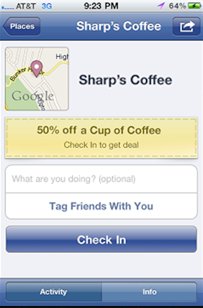 Gamification and G-commerce, gamification of E-commerce, are creating a lot of buzz across the globe. According to M2 Research, a gaming and technology researcher, gamification industry revenues will increase from less than 100 million dollars in 2010 to 1.6 billion dollars by 2015. Google on the other hand has invested recently 100 million dollars in the social gaming company, Zynga, and is planning to launch Google Games in the near future.
Gamification and G-commerce, gamification of E-commerce, are creating a lot of buzz across the globe. According to M2 Research, a gaming and technology researcher, gamification industry revenues will increase from less than 100 million dollars in 2010 to 1.6 billion dollars by 2015. Google on the other hand has invested recently 100 million dollars in the social gaming company, Zynga, and is planning to launch Google Games in the near future.
Gamification means using game mechanics for non-game apps and mobile/web sites to increase user participation; however “gamification of your brand” does not mean creating a new Farmville. It is not just about making things more fun or turning them into a game. It is about motivations, rewards and engagement.
#1 Set up your objectives
Before jumping into gamification, think thoroughly what exactly you want to achieve. Do you want to increase brand awareness, engage users or loyalize your existing consumers?
#2 Do research and get feedback from best customers
Gamification is cool, but it is very easy to get it wrong – especially if you are gamificating an existing service with an established user base. Do research and ask your best customers what motivates them. Some of them might be motivated by physical awards, some of them by social recognition and some of them by accomplishment only. It is important to get it right to avoid negative or lame reaction. If you really are not sure, test first with a small budget gamification project to see the reactions.
#3 Make sure your gamification is aligned with your brand/industry
There are many types of games, rewards, competitions, trophies, progress reports and other ways of recognition. If your “game” has nothing to do with your brand or your industry, it will only confuse people. Also, make sure it is suitable for your audience, since consumer and business customers and different age groups behave very differently.
#4 Use right gaming techniques for your users
Games are thought as fun, but they do not have to be. The point is finding a way to transfer the techniques that make games addictive for users to other things. By understanding what motivates the users and using the right techniques can reward them for doing things that ultimately help you to achieve your aims.
Fiat did this with the award winning eco:Drive. It is a fun, simple customer loyalty scheme where users could use USB sticks to analyse how they drive and receive suggestions for improvement so they could reduce their CO2 emissions and get better fuel economy. Also an online community called ‘ecoVille’ was created that was populated by consumers around the world using the ecoDrive technology.
Another example of this is the Nike Training Club, an app with an own personal trainer, which motivates users with customized work-outs and rewards. After first weeks of launch the app became iTunes App of the Week in the U.S. and reached the no.1 position in iTunes Health and Fitness category.
#5 Do not try to do it all
Like in Social Media, there is almost an unlimited choice of different and creative things you can do. But just like in Social Media – do not try to implement them all. Focus first on your goals (what behaviour you want to motivate) before you select the tools (which game techniques should you apply). Be selective and see what techniques would work best to achieve your goals.
#6 Do not make it too easy
People love completing a game and reaching the top level, but they love a challenge much more. It is much more motivating for users to really work for the achievement to reach it, than reaching it with a small effort. First level rewards and achievements should be relatively easy to trigger interest and get users engaged, but they should become more difficult to conquer closer the users are the end goal. Harder it is, more likely the user is going to share their achievement with the world.
#7 Do not focus only on extrinsic rewards
In gamification it is important to have extrinsic rewards such as prizes, position in ranking, badging, trophies etc. yet intrinsic motivators such as self-confidence, fulfilment, friendship and loyalty are equally important. Try to think a way to combine these two worlds to create even more satisfying experience.
#8 Use real-time feedback to improve the experience
Just launching a “game” is not enough. It requires commitment and as you start to see results, you may see potential for growth. A basic program may work as a novelty among the users, but in long term users will be asking and expecting much more than a simple trophy. Getting user’s feedback and ideas can help you to improve and offer your customers even better, engaging experience. Make extensions and enhancements to continue to evolve it for the most involved users.
#9 Take advantage of the Social Media
Use Social Media as a promotion, recognition, support and engagement tool. It is possible to increase participation in social media enormously if you get it right. For example, by allowing the user to publish the distance he ran in Twitter or Facebook or recognizing publicly the influencer of the day.
#10 Involve mobile
If the gamification has not focused initially on mobile site or apps, make it mobile friendly. With emerge of Smartphones, people carry Internet with them all the time and being able to influence and engage everywhere makes the user experience even more engaging. If the “game” is successful in the web, creating an app can enhance the program even further.
Highly-conscious opinion leaders
Typical gamer is not anymore the stereotypical “loner”, but can be anyone who wants to feel like an achiever. According to the report, gCommerce: The Gamification of eCommerce, gamers are actually highly-conscious consumers and opinion leaders, who are 50% more likely to be influencers among their friends. Gamers are also 20% more likely to be online shoppers than the average non-gamers. That is what makes the gamification so interesting for brands.
If the motivation is right and the techniques you selected encourage and reward the behaviours you want, you can give these users more reasons to spend time with your brand and tell others about it. If you do not listen to your users and get the motivation wrong, well that is another story.








I’d add to these decalogue and important eleventh point: graphics.
The game should be aligned to brand communications and realized at professional level to ensure his contribution to loyalty and brand awareness.